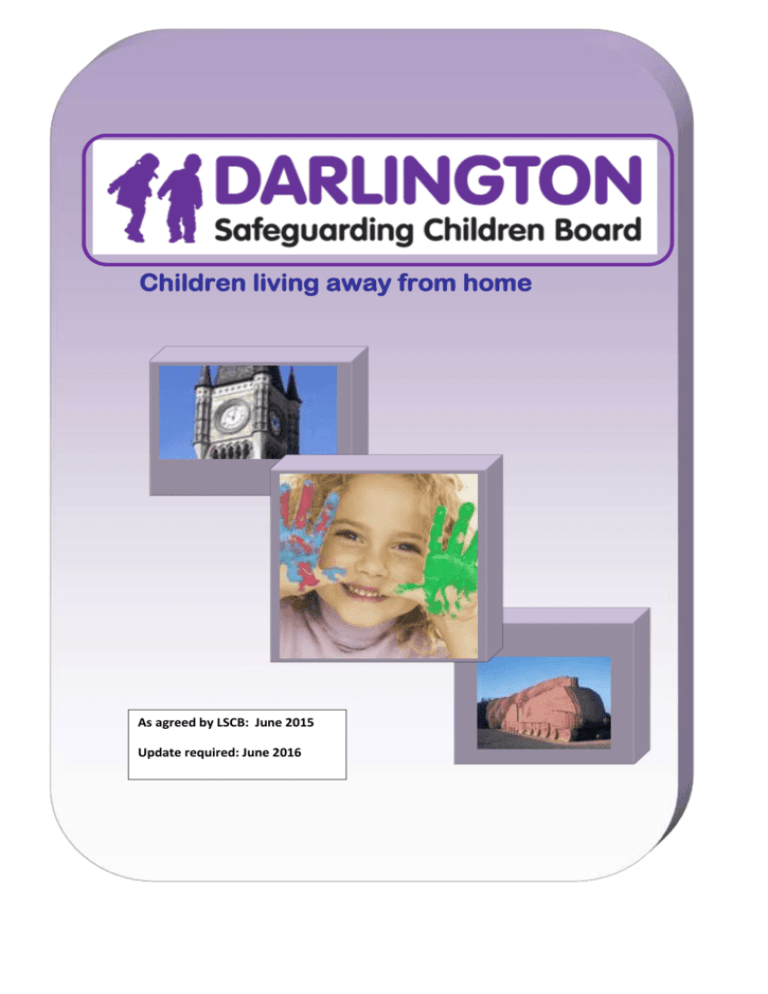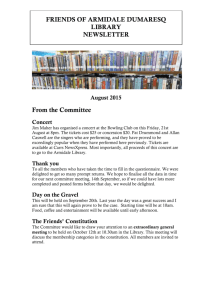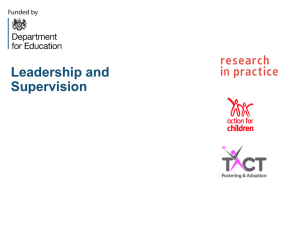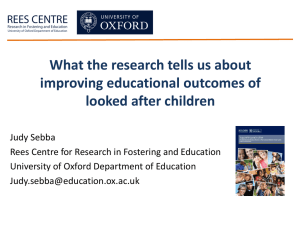Children living away from home
advertisement

Children living away from home As agreed by LSCB: June 2015 Update required: June 2016 Children Living Away from Home (including Children and Families Living in Temporary Accommodation) Introduction Revelations of the widespread abuse and neglect of children living away from home have done much to raise awareness of the particular vulnerability of such children. Many of these revelations have focused on sexual abuse, but physical and emotional abuse and neglect including peer abuse, bullying and substance misuse - are equally a threat in institutional and other settings. Concerns for the safety of children living away from home have to be put in the context of attention to the overall developmental needs of such children and a concern for the best possible outcomes for their health and development. Every setting in which they live should provide the same basic safeguards against abuse, founded on an approach that promotes their general welfare, protects them from harm and treats them with dignity and respect. These values are reflected in regulations and in the National Minimum Standards, which contain specific requirements on safeguarding and child protection for each particular regulated setting where children live away from home - see also Safer Recruitment, Selection and Allegations Against Persons who Work with Children Procedures. Essential Safeguards The following essential safeguards should be observed in all settings such as foster care, residential care, private fostering, armed forces bases, healthcare, boarding schools (including residential special schools), Prisons, Young Offenders’ Institutions, Secure Training Centres and secure units. Where services are not directly provided, these safeguards should be explicitly addressed in any contract with a service provider. All settings must ensure that: Children feel valued and respected and their self-esteem is promoted; There is an openness on the part of the institution to the external world and to external scrutiny; including contact with families and the wider community; Staff and foster carers are trained in all aspects of safeguarding children, are alert to children’s vulnerabilities and risks of harm, and knowledgeable about how to implement safeguarding children procedures; Children are listened to, and their views and concerns responded to; Children have ready access to a trusted adult outside the institution, e.g. a family member, social worker, independent visitor or children’s advocate. Children should be made aware of independent advocacy services, external mentors e.g.Child Line; Staff/carers recognise the importance of ascertaining the wishes and feelings of children and understand how individual children communicate by verbal or nonverbal means; Complaints procedures are clear, effective, and user–friendly and are readily accessible to children and young people including those with disabilities and those for whom English is not their preferred language; Bullying is effectively countered - see Tackling Bullying Procedure; Recruitment and selection procedures are rigorous and create a high threshold of entry to deter abusers and there is effective supervision and support that extends to temporary staff and volunteers; Contractor staff are effectively checked and supervised when on site or in contact with children; Clear procedures and support systems are in place for dealing with expressions of concern by staff and carers about other staff or carers (a Whistle-blowing Policy); There is respect for diversity, and sensitivity to race, culture, religion, gender, sexuality and disability; Staff and carers are alert to the risks of harm to children in the external environment from people prepared to exploit the additional vulnerability of children living away from home. Where there is reasonable cause to believe that a child has suffered Significant Harm, the Local Authority for the area in which the child is living has the responsibility to convene a Strategy Discussion/Meeting, which should include representatives from the responsible Local Authority that placed the child, if different. At the Strategy Discussion/Meeting it should be decided which Local Authority should take responsibility for the next steps, which may include a Section 47 Enquiry. Foster Care The Local Authority‘s duty to undertake a Section 47 Enquiry, when there are concerns about Significant Harm to a child, applies on the same basis to children in foster care as it does to children who live with their own families. When the concerns relate to a child placed in a foster home outside the area of the responsible local authority - see Children Moving Across Local Authority Boundaries Procedure. Where there is reasonable cause to believe that a child in foster care has suffered or is at risk of suffering significant harm in the foster placement, the Allegations Against Persons who Work with Children Procedure will apply and a Strategy Meeting will be held. In these circumstances, enquiries should consider the safety of any other children living in the household, including the foster carers’ own children, grand-children or any children cared for by the foster carers in their home as well as any children whom the foster carers may be caring for or working with outside their home in a voluntary or paid capacity e.g. teaching, faith or youth work, scouts or many other groups. As foster care is undertaken in the privacy of the carers’ own home, it is important that children have a voice outside the family. Social Workers are required to see children in foster care on their own and evidence of this should be recorded on the child’s records. Foster carers should monitor the whereabouts of their foster children, their patterns of absence and contacts, and follow the Missing Children procedures whenever a foster child is missing from their home. Private Fostering A private fostering arrangement is essentially one that is made without the involvement of a Local Authority for the care of a child under the age of 16 (under 18 if disabled) by someone other than a parent or close relative for 28 days or more. Privately fostered children are a diverse and sometimes vulnerable group which includes: Children sent from abroad to stay with another family, usually to improve their educational opportunities; Asylum-seeking and refugee children; Teenagers who, having broken ties with their parents, are staying in short–term arrangements with friends or other non-relatives; Language students living with host families. Under the Children Act 1989, private foster carers and those with Parental Responsibility are required to notify the local authority of their intention to privately foster or to have a child privately fostered, or where a child is privately fostered in an emergency. Teachers, health and other professionals should notify the local authority of a private fostering arrangement that comes to their attention, where they are not satisfied that the arrangement has been or will be notified. It is the duty of every local authority to satisfy itself that the welfare of the children, who are privately fostered within their area, is being satisfactorily safeguarded and promoted. This includes an initial visit to the child and private foster carers within one week of receiving notification that the placement has started and subsequent assessment under the Assessment Framework. The local authority must also arrange to visit privately fostered children at regular intervals. Children should be given the contact details of the social worker who will be visiting them while they are being privately fostered. All arrangements and regulations in relation to private fostering are set out in the Children (Private Arrangements for Fostering) Regulations 2005, which can be found at: Legislation website. When there are concerns about Significant Harm to a child who is privately fostered the local authority and all the other agencies have the same duties to make enquiries as they do to any other child. The concerns must be reported to the local authority where the private foster placement is located in accordance with the Referrals Procedure and the Safeguarding Children Procedures will be applied. Children in Residential Settings All residential settings where children and young people are placed, including children’s homes and residential schools, whether provided by a private, charitable or faith based organisation, or a local authority, must adhere to the Children’s Homes Regulations 2001 and all other relevant regulations and to the relevant National Minimum Standards. Clear records must be kept and reviews and inspections must take place in accordance with National Minimum Standards and regulations. Children in such settings are particularly vulnerable and must be listened to. All such establishments must have in place complaints procedures for children and young people, visiting and contact arrangements with social workers and Independent Visitors (for Looked After children), as well as parents, advocacy services. Where there is reasonable cause to believe that a child in a residential setting has suffered or is at risk of suffering Significant Harm, a referral must be made in accordance with the Referrals Procedure. The concerns may range from bullying or abuse by other children to allegations against staff - see Tackling Bullying Procedure, Abuse by Children and Young People who Display Sexually Harmful Behaviour Procedure and, where the concerns relate to a member or members of staff and/or the care the child is receiving in the residential setting, the Allegations Against Persons who Work with Children Procedure will apply and a Strategy Meeting will be held. When the concerns relate to a looked after child placed in residential care outside the area of the responsible local authority - see Children Moving Across Local Authority Boundaries Procedure. Children in Hospitals Hospitals should be child-friendly, safe and healthy places for children. Wherever possible, children should be consulted about where they would prefer to stay in hospital, and their views should be taken into account and be respected. Care should be provided in an appropriate location and in an environment that is safe and well suited to the age and stage of development of the child or young person. Children under 16 should not be cared for on an adult ward. Hospital admission data should include the age of children, so that hospitals can monitor whether children are being given appropriate care in appropriate wards. Hospitals must have policies in place to ensure that their facilities are secure and regularly reviewed. Any concerns about Significant Harm to a child within a hospital or health based setting must be referred to the Children’s Social Care Services in whose area the hospital is located in accordance with the Referrals Procedure. When the child has been in hospital for three months or more, the appropriate health/hospital trust must notify the Responsible Authority i.e. the local authority for the area where the child is normally resident or, if this is unclear, where the child is accommodated. This is so that the local authority can assess the child’s needs under the Assessment Framework and decide whether services are required under the Children Act 1989. No child known to Children’s Social Care Services who is an inpatient in a hospital and about whom there are child protection concerns should be discharged home without a referral to establish that the home environment is safe, the concerns by medical staff are fully addressed and there is a plan in place for the ongoing promotion and safeguarding of the child’s welfare - see the Referrals Procedure. For further reading and information see the National Service Framework for Children, Young People and Maternity Services (NSF) 2004 and the Public Inquiry into Children’s Heart Surgery at the Bristol Royal Infirmary 1984-1995: Learning from Bristol. Children in Custody The local authority has the same responsibilities towards children in custody as it does to other children in the local authority area. Young Offenders Institutions which accommodate young people must have policies and procedures in place which set out their duties to safeguard and promote the welfare of the children and young people in their care. Specific institutions in an area must ensure that there are links in place with the Local Safeguarding Children Boards and local authorities. Children of Families Living in Temporary Accommodation Placement in temporary accommodation, often a distance from previous support networks or involving frequent moves, can lead to individuals and families falling through the net. It is important that effective systems are in place to ensure that children from homeless families receive services from health and education, social care and welfare support services as well as any other specific services, because with frequent moves they may become disengaged from services. For example a child who is not registered with a school or a GP will miss out on basic services such as health screening, eye tests, immunisations and learning to read and write. Where a child who needs specific treatment misses appointments due to moves the problem may become an issue of Significant Harm. Temporary accommodation, for example bed and breakfast accommodation or women’s refuges, may be a location which is not secure and safe and where other adults are also resident who may pose a risk to the child. All concerns of Significant Harm to a child should be referred to Children’s Social Care Services in accordance with the Referrals Procedure. The local authorities’ responsibilities for homeless families are set out in the Statutory Framework Procedure.





